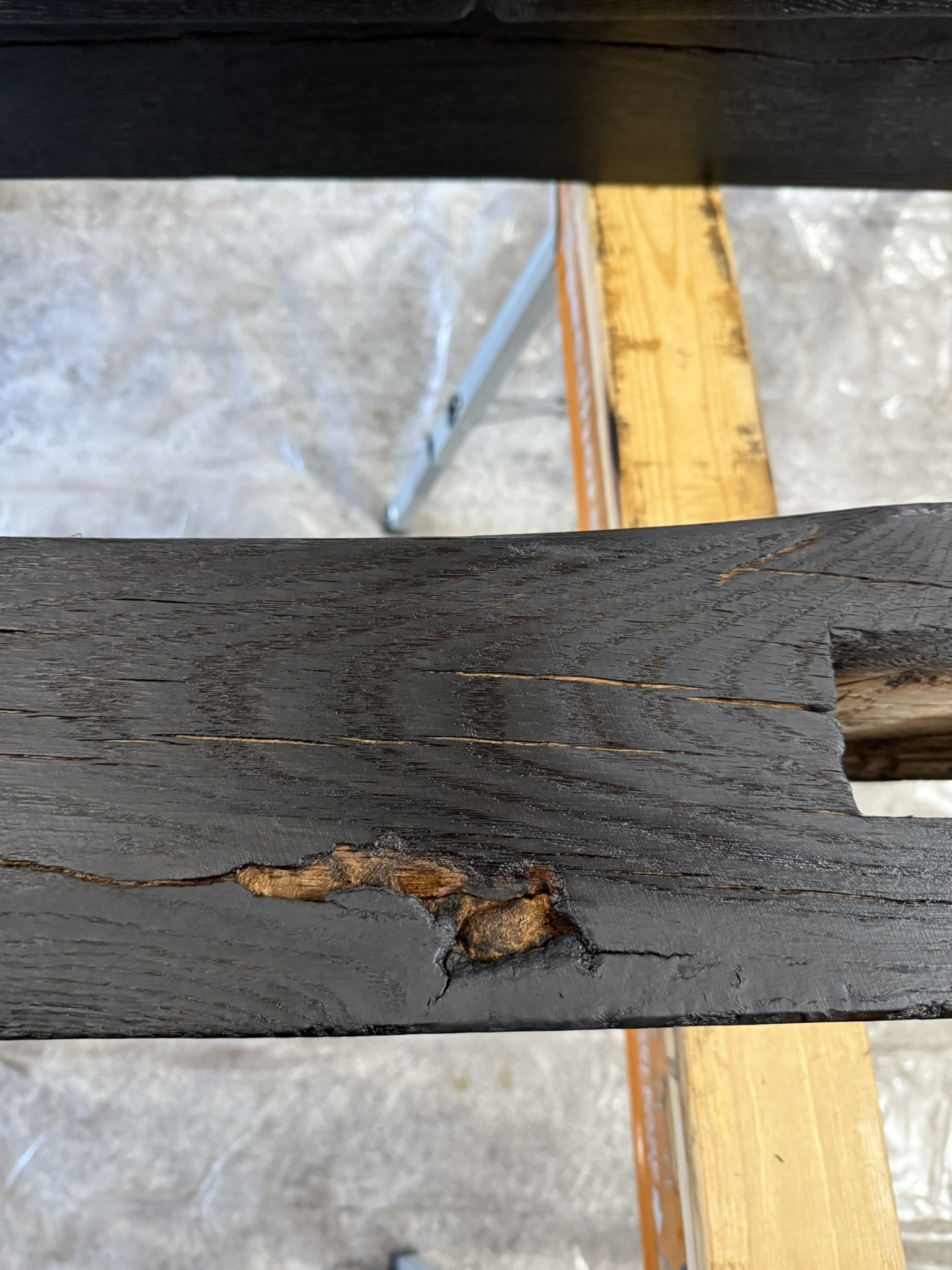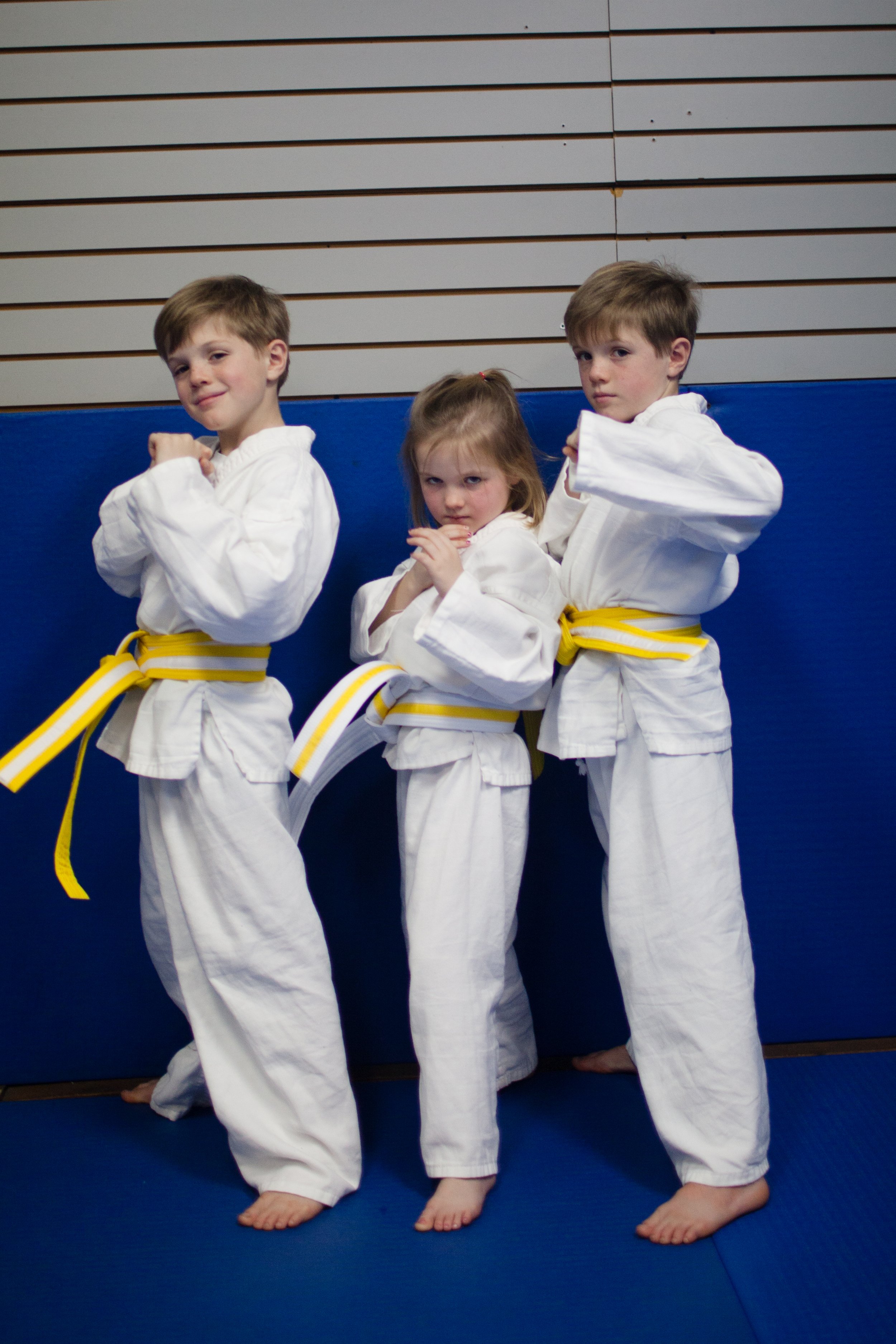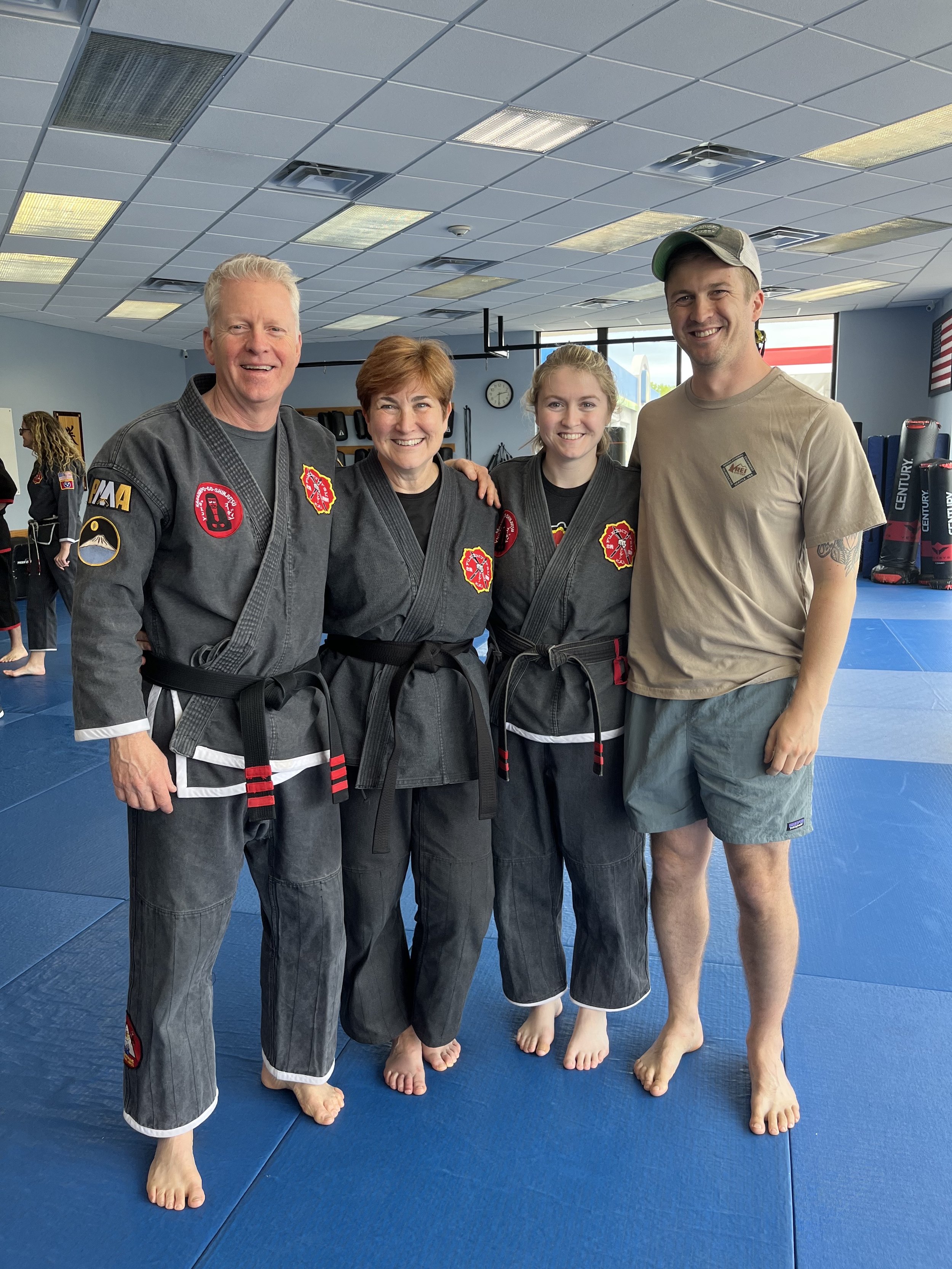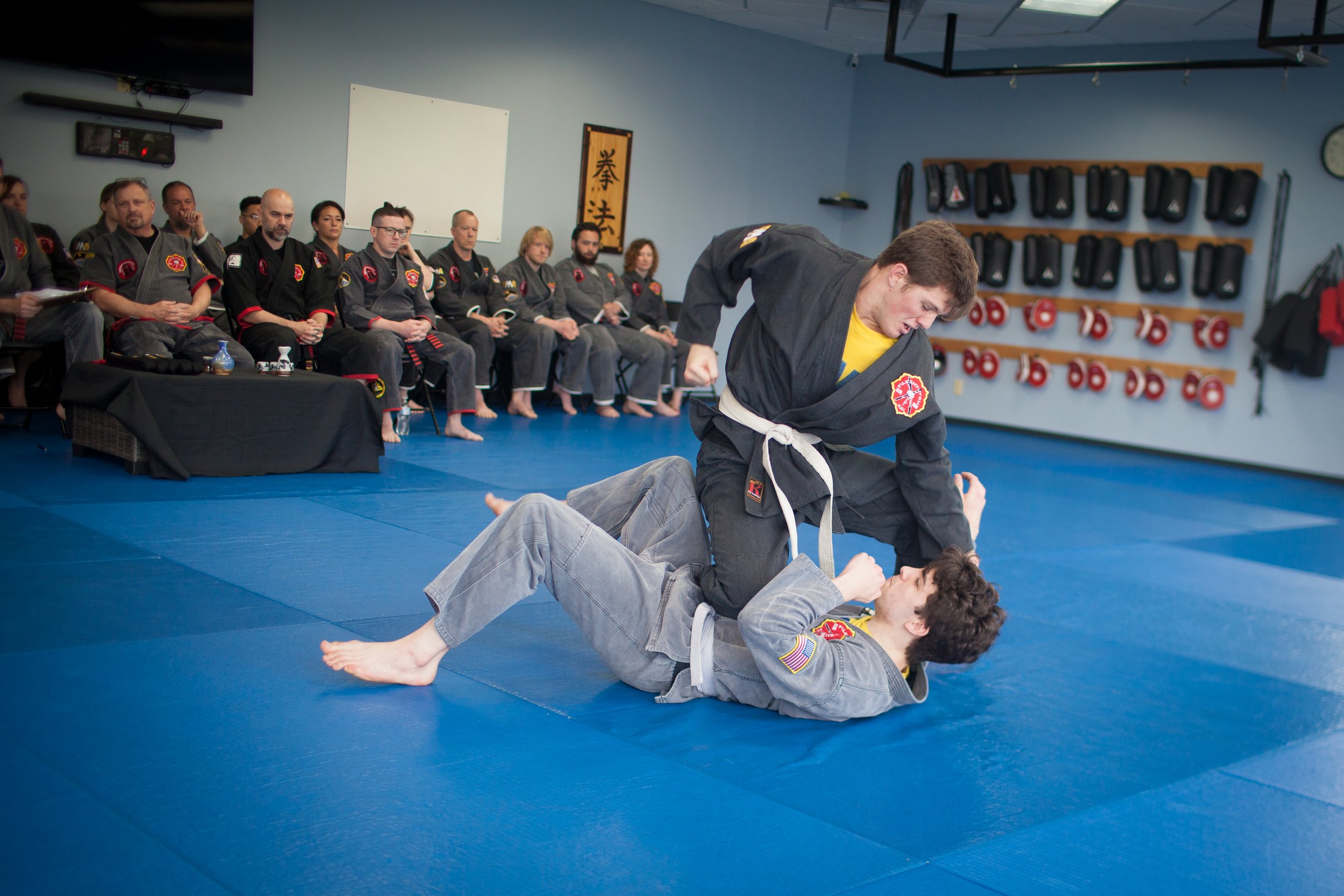“The greatest combat martial artists must face is with themselves.” - Joseph Cardillo
When I started my martial arts journey in 2016, all I thought I was doing was trying something new for a short time through an 8-week kickboxing class. Well, one thing led to another, and suddenly I’m preparing for my black belt test. Wow! How did this happen?!
People usually start training martial arts for a physical reason: exercise, self-defense, weight loss, etc. After I started training, I noticed my body getting stronger, as expected. But what I didn’t realize at the time was that learning martial arts is not just physical training; it’s equally mental. It actually wasn’t until one of my intermediate level belt tests that I realized my brain had also been changing.
Christine (yellow belt) with training partner, Becky
During that test, something unfamiliar happened to me. We were in the middle of a series of intense challenges. Everything was becoming hard to do and uncomfortable. This is a little hard to describe, but it seemed as if my awareness shifted from being active to being passive. Everything got less intense: the pain, the discomfort, my awareness of the room. I realized that I wasn’t feeling or thinking - I was just doing. I just kept going and kept following the instructions. After the test was over, I thought, “What was that? What happened to me?” It was that event that pushed me to try to figure out my brain and how it works and why it does what it does.
Around that same time, a fellow teacher introduced me to the Enneagram. I already knew my Myers-Briggs personality type, but the Enneagram differs from MBTI in that it is more “nurture” vs MBTI’s “nature”. The “Enneagram focuses primarily on internal personality traits and attempts to describe deep motivations, fears, and emotional drivers rather than purely behavior” (Crystal).
For a quick overview, the Enneagram divides us up into 9 types - each labeled as a number (1-9). There is a core desire and a core fear associated with each number. The number types relate and connect with each other in unique ways. Here is a chart:
After much research I decided that I was a type 9. Nines are called the “Peacemakers.” Our core desire is to have peace in our internal and external world, and our core fear is conflict and loss. After doing a lot of research and reading into the Enneagram, I was learning about how my brain works and my preferences. It was starting to show me how and why I was struggling with certain aspects of my martial arts training.
In looking back to some of my early belt tests, I would be sitting along the back wall running through techniques and material in my head. When something was instructed for someone else, I would think through it and make sure I could do it. After a few tests, I realized that I was expending more mental energy than I needed to and making myself mentally tired as a result. I realized that it was better to sit still and clear my mind and trust myself to be able to perform my material when needed. This was the first step I intentionally took to training my mind.
Christine receiving a stripe on her brown belt after a tough day of testing!
With that realization, I believe I was pushing myself towards experiencing what the Japanese call “mushin.” The suffix -shin translates to ‘mind,’ but words containing -shin are “often a reference to the attitude we carry into a stressful situation” (Lowery 45). Besides mushin, other words with this suffix are: shoshin (beginner’s mind), fudoshin (immovable mind), zanshin (remaining or lingering mind), isshin (one or unified mind), senshin (enlightened mind). In learning about these other “mind” words, I have started to find my search for internal peace. Of these words that I’ve encountered, the one that resonates with me the most is fudoshin. This is what I would like to aspire towards.
Christine during the public demonstration and final day of her 3 day black belt test.
So, what is fudoshin? Here are some quotes from different sources that try to explain the essence of the term:
[Fudoshin] is composure under pressure. It refers to a state of having an unwavering will. A spirit, undeterred by obstacles in the chosen path. It calls for a state of commitment coupled with fearless determination….One can maintain a state of mind unmoved by distractions. A state of internal tranquillity in the midst of external conflict (McKinnon).
Fudoshin: ‘Immutable in heart’. That state in which the mind is not troubled by anything external. A person knows no fear when faced with danger, aggression or unexpected events….It applies to a warrior who remains calm and imperturbable in all circumstances (Louis 33).
Fudoshin, a term meaning calm spirit, even when faced with danger, without fear or confusion, that does not dwell or become fixed on anything. This was the highest attainment of spiritual skill only attainable when the mind is totally focused on the totality of sensory input and free of thoughts and emotions - detached but aware and present (Caile).
Through these quotes that I have chosen to represent fudoshin, I see two main components or obstacles to overcome in order to achieve this state of mind: 1. Total awareness of your surroundings, and 2. Not having a fear response when something unexpected happens.
Christine receiving her Black Belt in FILKENJUTSU Kenpo.
Imagine that you are walking through the woods in autumn. You are alone. The temperature is cool and perfect, the wind is gently blowing through the tall trees, there are no bugs flying around, the sun is warm on your face, the birds are chirping in the background, the leaves under your feet are crackling as you step on them. You’re not actively thinking about any of those individual things - actually, you’re not thinking about anything at all. You’re taking it all in as a complete package. You have total awareness of your surroundings. To me, this is the first step to achieving fudoshin. It’s easy to find total awareness in an environment like this, but not as easy when you’re back in civilization, or in a sparring match.
Having total awareness of your surroundings can benefit you in many ways. It’s essential for self-defense when you’re out by yourself. Or, for an extreme example: In the movie Jurassic Park, when Muldoon (the game warden) is stalking the raptor towards the end of the movie, his whole attention is trained on the distant threat he is targeting. Then another raptor appears out of the brush next to him - too close for him to react - to which he responds, “clever girl” before his demise. If he had had total awareness of his surroundings instead of total focus on one thing, perhaps he would have survived.
PMA Oak Ridge FILKENJUTSU Black Belt Class of 2021
Imagine that scene in the woods again. Your awareness is not focused on anything in particular, you’re enjoying your calming walk in nature when suddenly you catch a spider web on your face! Ack! Now all of your attention is focused on those sticky strings on your face and as you try to wipe them all off, your foot catches a tree root and you stumble. You got caught unaware because your whole mind was fixated on that dang spider web. You were startled and no longer aware. This is the second point that needs to be overcome: having a fear response at an unexpected event.
A fear response can be something as simple as a sudden distraction - anything that pulls your attention away from your total awareness and fixes it on one point. In most cases it’s healthy to have a fight-or-flight response, but in order to achieve fudoshin (immovable mind), we need to be able to not have the fear response triggered. If your mind is immovable, then these experiences won’t faze you; your attention won’t be hyper-focused on the one event and you won’t lose your cool. To me, it means that my internal peace was disrupted.
Female FILKENJUTSU Black Belts!
So then, how do we overcome this? I imagine it starts with mental toughness training. If you are constantly having trouble with a fear response, then you are going to have to work through it and diffuse it. There is a mental training strategy called habituation. “Habituation involves repeated exposure to stimulus that triggers an undesirable response (in this case, fear.) Frequent exposure acclimates the individual to the stimulus, thereby diminishing the unwanted response” (Zahairiades, Loc 1562).
The first time I got punched in the body while sparring, it took me a few long seconds to recover. I know I had a fear response and all sorts of thoughts and feelings ran through my head. My mind got stopped. Luckily, I had a nice partner who didn’t keep punching me in my recovery moment. If it had been a real attack, that attacker would have taken advantage of my pause. After training a few years, it became easier to get punched because I was more familiar with the sensation and my response to it. It still phases me, but nowhere near like it did that first time.
While I’m glad that I don’t fall on my face while trying to do a push-up anymore, the mental toughness that I have gained has been much more rewarding for me. In my quest for internal and external peace, I have been led towards finding fudoshin. I may never get there, but I know that I couldn’t have gotten where I am now without my martial arts training, and without the people who have been alongside me through this amazing journey.
References
Allen, Brian. Fudoshin Kenpo Jujitsu: Martial Art and Self-Preservation System. Kindle Edition, 2016.
Caile, Christopher. “Fudo: The Concept of Immovability.” Fighting Arts, 2017. www.fightingarts.com/reading/article.php?id=60.
Cardillo, Joseph. Be Like Water: Practical Wisdom from the Martial Arts. Warner Books, 2003, New York.
https://www.contemplative.org/wp-content/uploads/2017/11/Enneagram-Stress-n-Relax.jpg
Enneagram Institute. 2021, www.enneagraminstitute.com/.
“The Enneagram Test.” Crystal, 2021, www.crystalknows.com/enneagram-test.
FitzGerald, Gareth. Martial Arts and Mental Health: How they Help Us Heal and Grow. Kindle Edition, 2020.
Frederic, Louis. A Dictionary of the Martial Arts. Charles E. Tuttle Company, Inc., 1988, Boston.
Gardner, Daniel. The Science of Fear. Penguin Group (USA) Inc., 2008, New York.
Lowery, Dave. The Essence of Budo. Shambhala Publications, 2010, Boston.
McKinnon, Thomas D. “What is Fudoshin? And How to Achieve It?” The Dojo, November 14, 2019, the-dojo.org/2019/11/14/what-is-fudoshin-and-how-to-achieve-it/.
Nicol, C. W. Moving Zen: Karate as a Way to Gentleness. Kindle Edition, 2013.
Riso, Don Richard. The Wisdom of the Enneagram: The Complete Guide to Psychological and Spiritual Growth for the Nine Personality Types. Bantam, 1999
Suzuki, Shunryu. Zen Mind, Beginner’s Mind. Shambhala Publications, 1970. Kindle Edition, 2011.
Takuan, Soho. Fudochi Shimmyo Roku. Translated by Tenshin Tanouye. Kindle Edition, Daihonzan Chozen-ji / International Zen Dojo, 2016.
Zahariades, Damon. The Mental Toughness Handbook. Kindle Edition, 2020.






























































